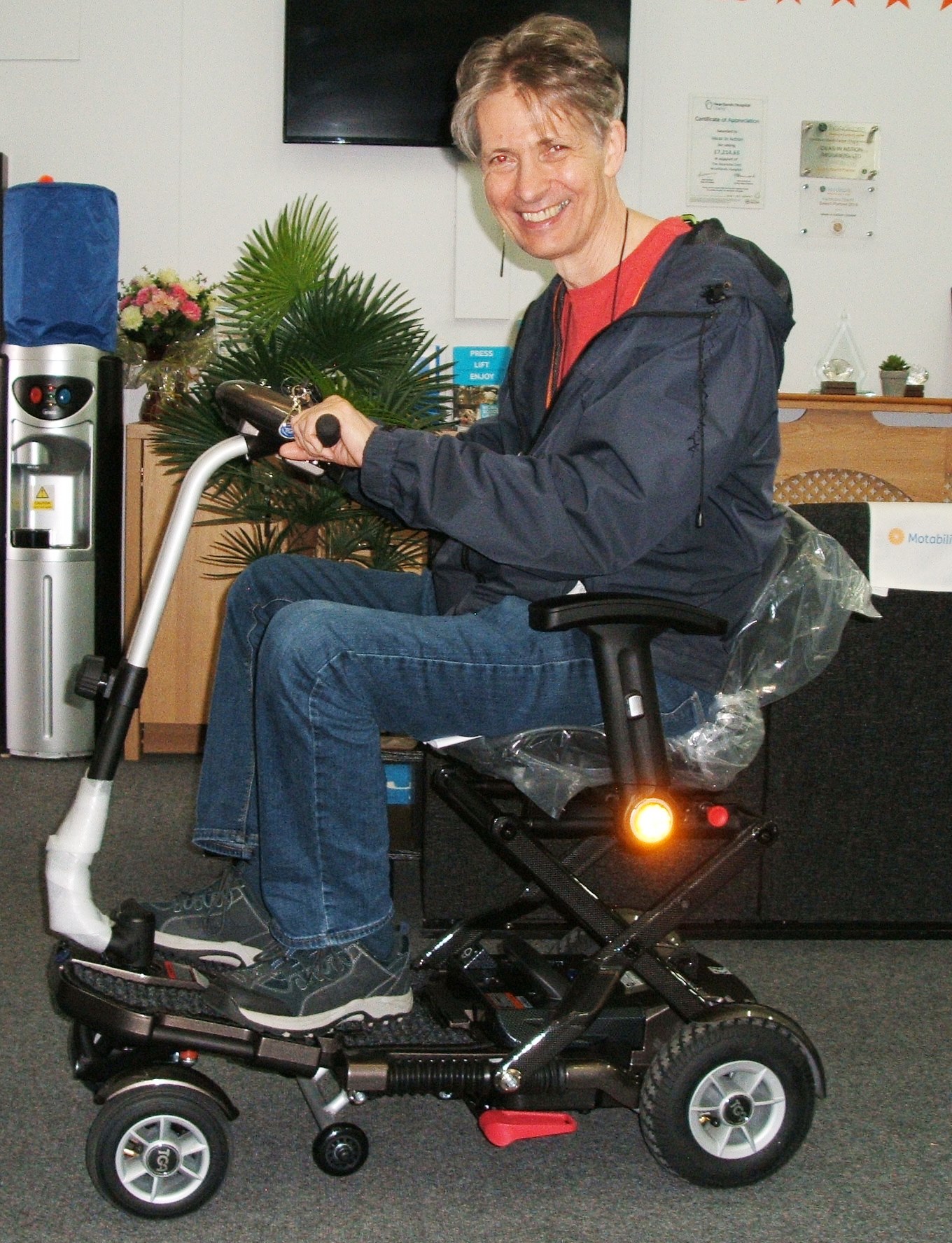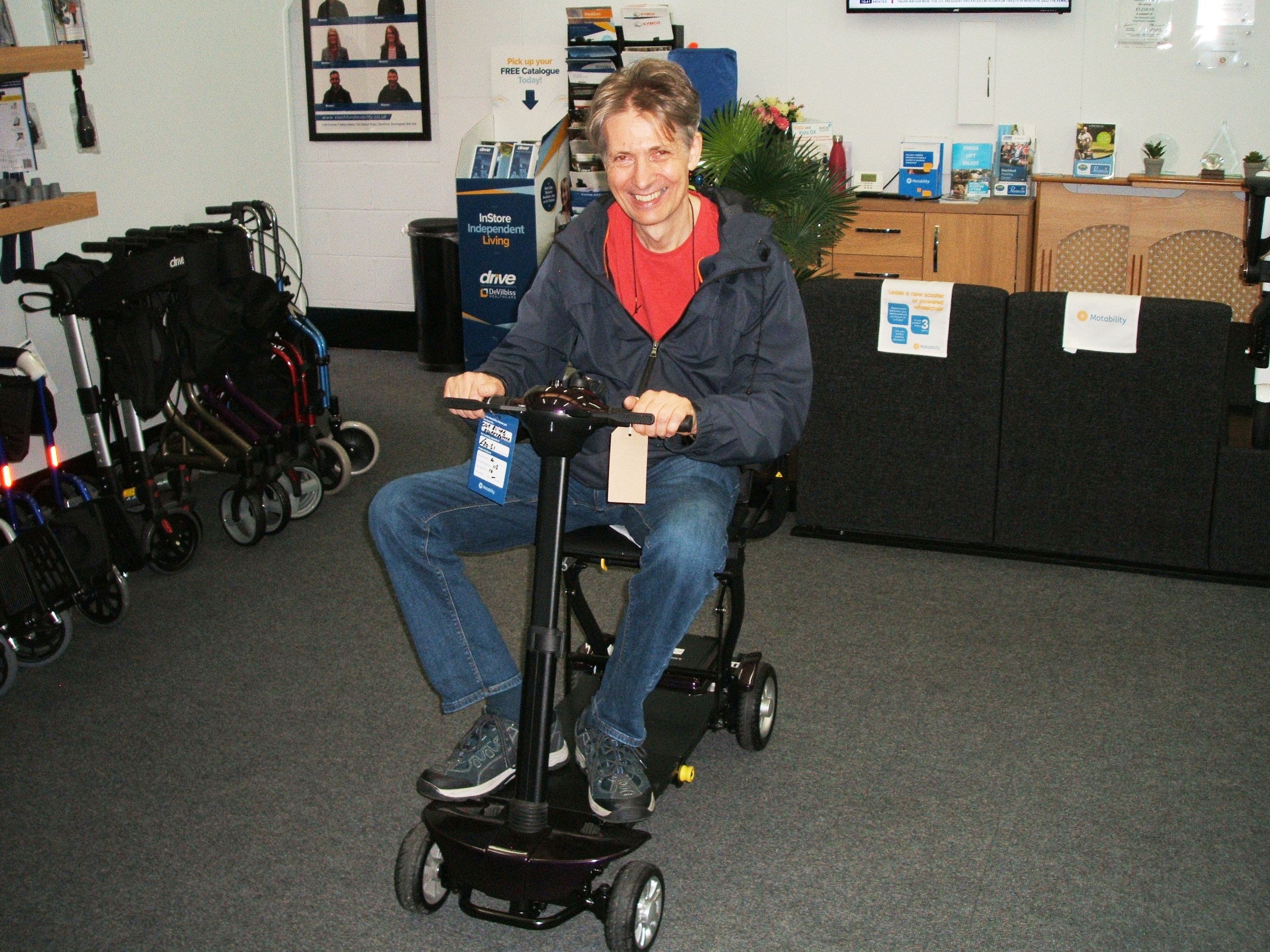During a recent review of folding mobility scooters, available on the Motability Scheme, independent journalist Ian Cook was surprised to find that all four scooters were powered by lithium-ion, not lead-acid batteries. In this article he delves deeper into this interesting power source.
Up to 2019, I knew very little about lithium-ion batteries. Yes, I had on occasion bought lithium re-chargeable batteries for my telephone handset, and I also knew lithium batteries were used in smartphones and laptops. However, it never occurred to me that lithium batteries could power something as big as a mobility scooter.
So, I was surprised to find they could do and did just that. With a range of up to 12 miles lithium-ion powered boot scooters like the TGA Minimo Plus 4, they can go a long way.
Ian on the lithium powered TGA Minimo Plus 4
The pros of using lithium-ion batteries
Lithium is a very light metal extracted and refined from the soil in certain parts of the world. There is quite a lot of it around, but its use in batteries dates only from 1980, so it’s a relative newcomer to the battery world. It is one of the lightest chemical elements and also has one of the largest electrochemical potentials (i.e. is capable of holding more electric charge) and all this is packed in compact and light batteries.
Weight, or rather its lightweight, is the most obvious advantage of lithium over a lead-acid battery and is self-evident the moment you pick one up. If lead is one of the heaviest metals around then lithium is one of the lightest. This means you can easily carry your lithium-ion battery out of the scooter and recharge it with ease.
But weight isn’t the only advantage. Not only are lithium-ion batteries lighter they are also longer lasting and they charge faster. Manufacturers say that lithium-ion batteries are also the perfect green alternative to lead-acid batteries and this is true insofar as their longer life span means they generate less waste to be recycled than lead-acid batteries.
Click here to find out about choosing the right mobility scooter for you.
Things to consider
There are however some practical points you need to consider before choosing lithium-ion over lead-acid batteries. The first is that lithium-ion batteries are at present more expensive, although it should be said that this price difference will even out as lithium-ion battery manufacture becomes more widespread.
The second is that air travel can presently bring complications for lithium-ion powered mobility scooters and different airlines may have different policies regarding carrying what is a relatively new type of battery. Lithium can deliver high outputs of energy, making it more of a potential hazard, so airline staff generally want to ensure that they can see lithium-ion batteries during the flight and will almost certainly ask you to carry them as hand luggage rather than putting them in the hold. As the batteries are pretty light that’s no problem. It is best to check with your airline beforehand.
Ian on the lithium powered One Rehab Globe Trotter
Conclusion
So, given its many advantages will there be a time when all mobility scooters, both class 2 and 3, are powered by lithium-ion rather than lead-acid batteries? This is, of course, the great unknown. In principle, there is no reason why lithium-ion should not expand beyond the class 2 boot scooter market into the bigger battery class 3 road scooter market. And it seems that this is likely to happen.
Perhaps one reason to think this is that the UK government said in 2019 that by 2040, all new cars should be zero-emissions capable – which essentially means electric. And what type of electric battery is most commonly used in these cars? Yes, that’s right, lithium-powered batteries. As lithium-powered batteries can power cars, mobility scooters of all sizes should present no problems.
The Motability Scheme enables you to exchange all or part of your mobility allowance for a mobility scooter, powered wheelchair or car. You can find out more about joining the Scheme here and you can use our search tool to browse the Scheme’s full range of scooters.
Related articles
Test drive: Lightweight scooters put to the test
Mobility scooter range: How far can yours travel?
![]()










